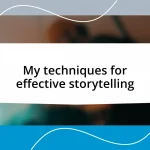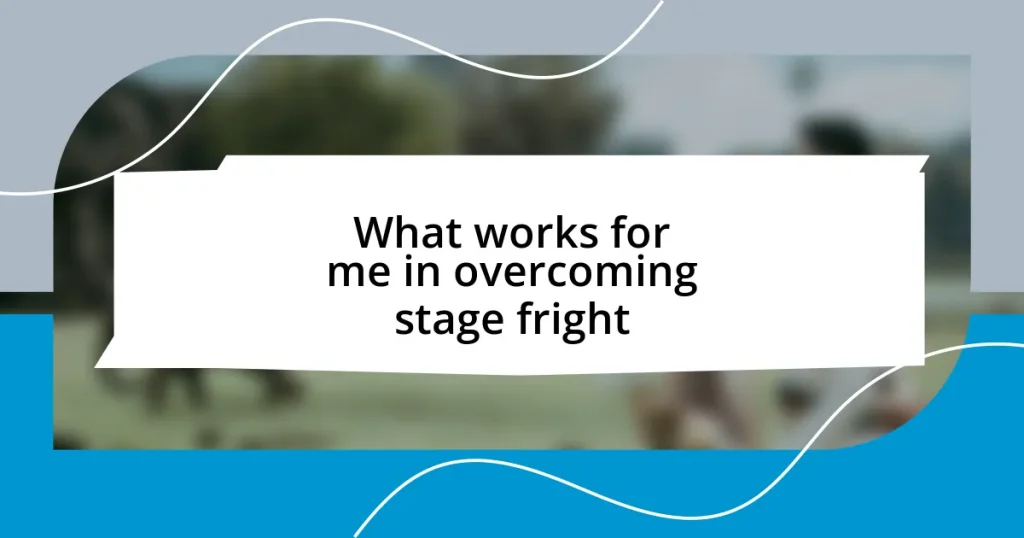Key takeaways:
- Stage presence is built on authenticity, audience connection, and vulnerability, transforming performances into engaging experiences.
- Body language, including posture and eye contact, plays a pivotal role in communication and audience engagement.
- Engaging the audience through open-ended questions and relatable anecdotes fosters a shared dialogue, enhancing the overall experience.
- Practicing vocal techniques and intentional movement can significantly improve delivery and capture the audience’s attention.

Understanding stage presence
Stage presence isn’t just about how you move on stage; it’s about how you connect with your audience. I remember the first time I stepped onto a stage, heart racing and palms sweating. I felt invisible, even with the spotlight focused on me. I started to wonder, what does it really mean to be “present” in front of others?
Understanding stage presence means recognizing that your energy and authenticity can captivate an audience. I’ve experienced this firsthand when delivering a speech. The moment I let go of my fears and allowed my passion to shine through, I noticed the audience leaning in, their eyes locked on me. It’s fascinating how a genuine connection can transform a performance from mundane to magical—don’t you think?
Another key aspect is that stage presence evolves with practice and self-awareness. In my journey, I learned to embrace small moments of vulnerability, like sharing a personal story or a fleeting doubt. It creates an emotional link that audience members appreciate. Have you ever considered how your own stories might resonate with others? Understanding this intertwining of vulnerability and confidence has been pivotal for me, shaping not just my presentations, but also how I interact with people off the stage.

Importance of body language
Body language is a powerful tool in communication. I’ve found that my posture can set the tone even before I utter a word. For instance, when I began adopting an open stance—shoulders back and arms relaxed—I noticed people responded with more engagement. It’s almost as if my body was speaking before my mouth even opened. Just sitting up straight can convey confidence, drawing the audience in.
Moreover, eye contact plays a crucial role in establishing a connection. I used to look at the floor or over people’s heads, but once I made a conscious effort to engage by locking eyes with individuals in the crowd, the atmosphere shifted dramatically. Suddenly, it felt less like a performance and more like a conversation, allowing me to gauge their reactions and adapt my delivery in real time. Have you ever felt that spark when you see someone nodding in understanding?
In contrast, negative body language such as crossing arms or fidgeting can create a barrier. I learned this the hard way during a presentation early in my career. I was nervous, which made me unconsciously close off, and I could sense the audience retreating. Recognizing the impact of these cues taught me to be mindful of my movements. Most importantly, I’ve come to realize that authenticity in body language authentically expresses who I am.
| Positive Body Language | Negative Body Language |
|---|---|
| Open stance, relaxed arms | Crossed arms, fidgeting |
| Consistent eye contact | Averted gaze, looking down |
| Smiles and nods to engage | Stiff posture, lack of expression |

Engaging with the audience
Engaging with the audience is all about making that emotional connection. I recall a moment during one of my talks when I paused to ask a question, letting the audience voice their thoughts. The energy shifted; it was no longer just me talking at them but a shared dialogue. It felt incredibly rewarding to see them leaning in, eager to respond. I learned that inviting participation can break down barriers and foster a sense of community in the room.
To foster this connection, I like to use these strategies:
- Ask open-ended questions to spark discussions. It turns the spotlight away from just me and invites others in.
- Share relatable anecdotes that resonate with the audience, making them feel like they are part of my story.
- Encourage audience reactions, such as nods or laughter, to create a dynamic atmosphere. Their responses guide me, making it feel more like a conversation.
- Use a conversational tone, which can make me seem more approachable and relatable to the audience.
It’s these little moments of interaction that truly deepen the connection, transforming a standard presentation into a memorable experience for everyone involved.

Practicing vocal techniques
Practicing vocal techniques has been a game changer for enhancing my stage presence. I remember when I first started experimenting with different vocal warm-ups; it felt awkward at first, but I quickly discovered how much my voice impacted my delivery. For instance, I often vocalize scales or even simple hums to loosen up my vocal cords, which not only helps with projection but also calms my nerves. Have you ever noticed how a strong voice can grab the audience’s attention?
In my experience, mastering breath control was another vital aspect. When I learned to take deep breaths from my diaphragm, it transformed not just my vocal strength but the way I felt on stage. I used to feel winded after just a few sentences, but now, I can speak confidently for much longer without losing my breath. This shift not only improved my delivery but also made me more aware of pacing, allowing me to emphasize key points. It’s exhilarating to feel the power in my voice as I take command of the room.
Finally, I’ve found that varying pitch and tone carries so much weight in storytelling. I recall during one presentation where I deliberately lowered my voice when discussing a profound message, and the shift in the room was palpable. The audience leaned in, captivated. It made me realize how effective vocal dynamics can be; I often ask myself, am I truly conveying the emotion behind my words? Practicing these vocal techniques enables me to connect on a deeper level, turning every speech into a memorable experience for both myself and my audience.

Mastering movement and space
Mastering movement and space on stage is crucial for enhancing my presence and connecting with the audience. I noticed that when I moved purposefully, it commanded attention. There was one time I found myself rooted to one spot during a talk. My energy felt flat, and so did the audience’s response. After that experience, I made it a point to explore the stage more, using my body to illustrate my points. It’s fascinating how a simple shift in position can change the dynamics—like stepping forward to make a key point, I can draw them in, creating a shared moment of engagement.
Understanding personal space also had a profound effect on my stage presence. Early on, I often stood too far from the audience, making it difficult to foster a connection. During a workshop, an instructor pointed out that moving closer could diminish that invisible barrier. The next time I presented, I dared to step within that zone. The smiles and nods from the audience weren’t just encouraging; they made me feel like we were all in this together, sharing the experience rather than me just presenting to them.
I’ve also realized the importance of using gestures to complement my words. I remember a moment when I was speaking about overcoming challenges, and I instinctively made a fist to emphasize my determination. The impact of that motion was immediate; I could see the audience respond, their faces lighting up with recognition and empowerment. Have you ever noticed how certain gestures resonate more deeply than words alone? These movements help in conveying emotions that words may struggle to express, ultimately enriching the story I’m sharing.

Overcoming stage fright
When it comes to overcoming stage fright, acknowledging that it’s a common struggle can be comforting. I remember my first big presentation; my heart raced, and my palms were sweaty. In those moments of panic, I learned that shifting my focus from my own anxiety to the audience’s experience made a huge difference. Have you ever considered how much everyone else is rooting for you? Realizing that my audience wanted me to succeed allowed me to channel that nervous energy into enthusiasm instead.
One technique I found particularly helpful was visualization. I’d spend a few minutes before going on stage imagining myself delivering the talk with confidence and grace. One time, I vividly pictured the audience laughing at my jokes and nodding in agreement, which set a positive tone in my mind. It’s amazing how this simple mental exercise can transform fear into excitement. Have you tried visualizing success before stepping on stage? Trust me, it can change your entire perspective.
In addition to mental preparation, grounding exercises became my lifeline. Whenever I felt the familiar grip of stage fright, I practiced a quick technique of pressing my feet firmly into the ground and taking slow, deep breaths. This act of grounding not only calmed me down but also reminded me of my presence on stage. I distinctly recall a time when I felt overwhelmed, but taking those moments of stillness helped me regain control and focus. Have you found that certain physical actions ground you when anxiety strikes? These small, mindful practices can make a world of difference in how I approach speaking engagements.

Reflecting on performance feedback
Reflecting on performance feedback has been a game changer for me. After every presentation, I make it a point to seek out constructive criticism, whether from peers or the audience. I remember vividly when a colleague pointed out that my voice often trailed off at the end of sentences. At first, I was defensive, but then I realized they were right. It was a simple shift in delivery that could make my message much clearer and more impactful. Have you ever had feedback that initially stung but later turned out to be invaluable?
Hearing direct response from my audience has opened my eyes too. I recall a particular instance where someone in the front row smiled and nodded throughout my talk. Afterward, they told me how my energy lit up the room, igniting their own enthusiasm for the topic. This feedback showed me the power of connection and reminded me that when I’m engaged and animated, the audience feels it too. Do you pay attention to these little signs during your performances?
Moreover, I journal my reflections after each event to track my growth. This practice allows me to see patterns over time, revealing what resonates with my audience versus what falls flat. One entry noted a moment when I paused for effect, and the audience’s surprised reaction was palpable. Looking back, that simple moment of stillness made a significant impact. Have you ever analyzed your own performances in this way? There’s immense value in understanding not just the feedback but also how it aligns with your personal journey as a speaker.
















